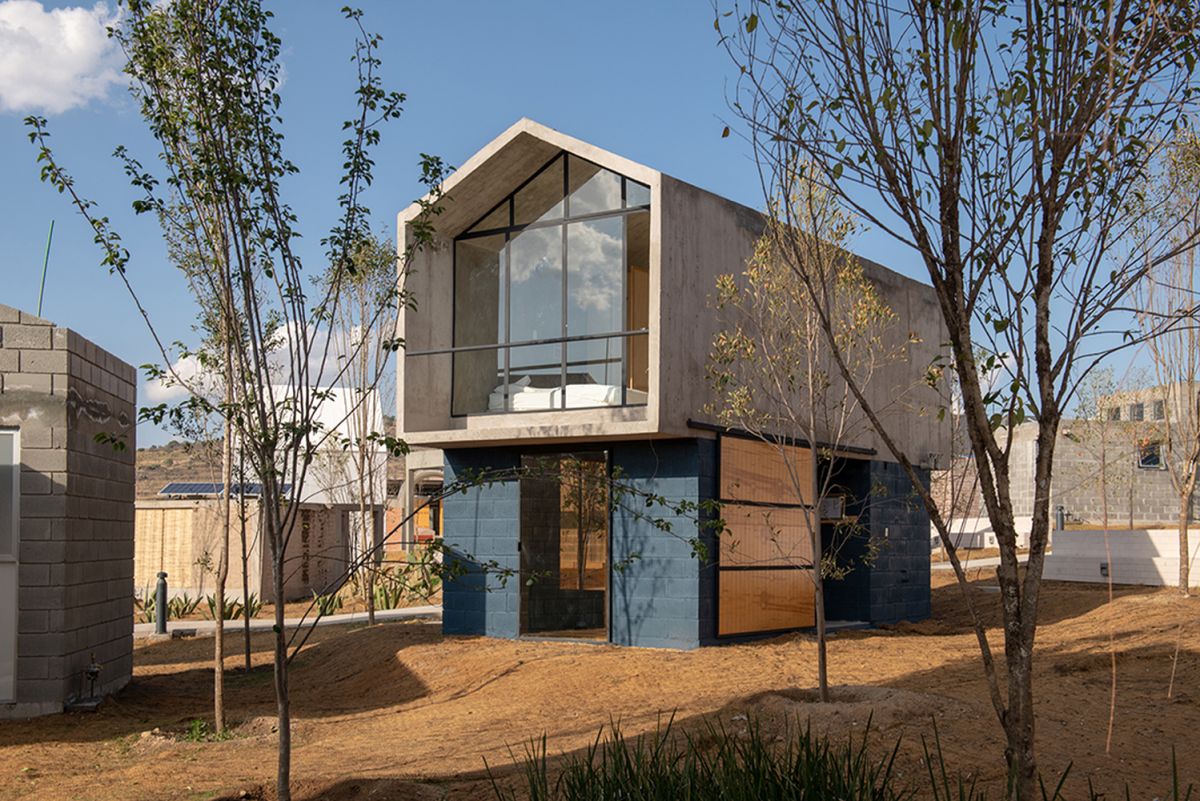Designed by Francisco Pardo Arquitecto the Apan Prototype is part of the project “Del Territorio al Habitante” (“From the Territory to the Inhabitant”). This research program, promoted by INFONAVIT (Housing Institute of Mexico) through the Investigation Center for Sustainable Development (CIDS), seeks to improve the quality of rural-housing and assisted self-construction in the Mexican territory.
The project, which includes experimental proposals by several architectural studios, inspired the creation of a Housing Laboratory in Apan, Hidalgo (Mexico), where 32 housing prototypes were built with the purpose of studying social housing in specific local contexts throughout different regions of Mexico.
Among the others, the systemic prototype by Francisco Pardo Arquitecto is intended to be developed in various rural sites of the municipality of Panotla, in the state of Tlaxcala (Mexico) and is made up of several parts, related through a set of rules and procedures that keep them together and regulate their collective functioning.
In this proposal, two main elements are the matrix of parceling. First, a perimeter of 8 meters in diameter made of eight wooden fences – of 3 meters each – which circumscribes 50 sqm of private land to enclose the house and to be used for agriculture or livestock. Second, a block structure, with a base of 18 sqm, which includes a small kitchenette, a bathroom and a free space that can be turned into a bedroom. In the upper part, a further multipurpose space can be used as a warehouse to store crops or materials.
The Apan Prototype facilitates the adaptation of its exterior and interior environments to the inhabitants’ needs: the private land expands as the family or production grows; while the second internal floor can be used for more specific purposes, even converting the residence into a 36 sqm housing unit.
The spaces on the ground floor are clearly organized and oriented along perpendicular axes, and physically connect to the external yard to encourage its cultivation; while the versatile second floor features large windows that open onto the surrounding landscape.
Externally, the house has no clear front: it stands out as an iconic object in the landscape, raised off the ground, with its standard, typological shape – that of a generic house – as the primary feature. The circular, modular fence works at community scale, fostering integration rather than separation between adjacent constructions, while simultaneously creating individual green spaces and public areas with different morphologies and uses.
The habits of each family shape the private rooms, while collective self-regulation designs the intermediate spaces between the single parcels, molding social and shareable programs.
Francisco Pardo’s residential model – as the overall initiative – effectively offers the opportunity, to families with more modest means and in confined spaces, to personalize daily domesticity, making the inhabitants feel part of a community and consolidating the link between them and the territory.
Other images can be seen in the gallery down below
Project name: Apan Prototype
Architecture Office: Francisco Pardo Arquitecto
Principal Architect: Francisco Pardo
Client: INFONAVIT (Housing Institute of México), CIDS (Investigation Center for Sustainable Development)
Design Team: Francisco Pardo, Ivan Saucedo, Karen Burkart, Wilfrido Estrada, Víctor Cruz, Sophia Alami, Daniel Vázquez, Erick Trejo
Location: Apan, Hidalgo, México
GFA: 36 sqm
Photography: Jaime Navarro
About Francisco Pardo Arquitecto
Architect with a Master’s Degree in architecture from Columbia University in New York. He was awarded with the young creators scholarship in 2001 and is a member of the Mexican National Creators System since 2010 by the Arts and Culture Ministry.
In 2016, he founded Francisco Pardo Arquitecto practice in Mexico City. Formerly, in 2000, he founded with Julio Amezcua AT103, an architectural firm where they developed projects on different scales and received several awards. In 2008, the Ave Fenix Fire station earned them a silver medal in the Mexican Architecture Biennial and the first place in the Best Institutional Building category at the International Design Festival. In 2009, Pardo was awarded the title, “Emerging Voices” by the Architectural League of New York, the most important recognition for emerging firms that distinguishes new practices in North America. In two consecutive occasions, Pardo received the silver medal for “best housing building” at the Mexican Architecture Biennale and also won the Grand Jury Prize at the Pan American Biennial of Quito, Ecuador. In 2011, he won the 1st prize in the competition by invitation for the renovation of “Palacio de Lecumberri” a former prison that currently hosts the General Archive of the Nation. Pardo also received the 1st Price in Milan’s 2014 ArchMarathon for Havre 69.
His practice was named by London’s Wallpaper magazine as one of the World’s 50 hottest young architect practices and ranked by Icon magazine of London as one of the 50 design and architecture firms that are shaping the future.His work has been published and exhibited internationally; he has lectured at many institutions in countries such as China, Spain, USA, Italy, Germany, Venezuela, Brazil, Chile, Argentina, Colombia and Mexico - among others.
Francisco Pardo has redirected his efforts toward more local and more social architecture, understanding this discipline as a tool for social development of his country and the world. He’s currently working on the project San Juan Pugibet market in Mexico City, a rural school in Puebla, and social housing and various recycling projects in Mexico.
He has taught architecture in Iberoamericana University, where he coordinated the housing workshop for 4 years. He has been a Master’s Degree visiting professor at UPenn in Philadelphia and UC Berkeley in California, where he was named “Fridman Professorship” in 2010. Currently he teaches at the Southern California Institute of Architecture in Los Angeles (SciArc), where he coordinates the program SciArc-Mexico.

